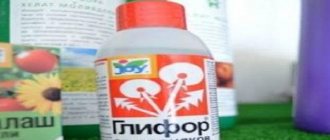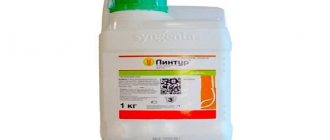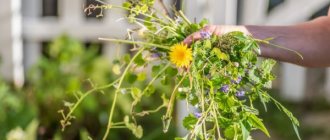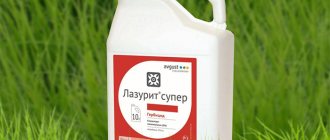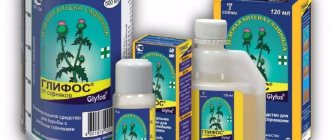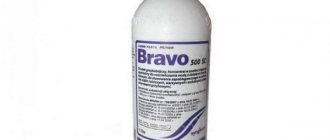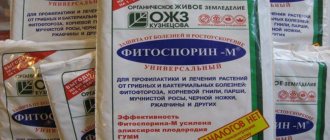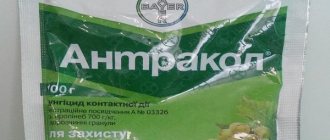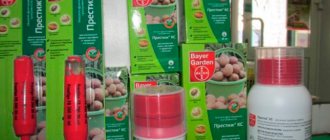Composition, purpose and release form of the drug "Agrokiller"
The universal herbicide “Agrokiller” is produced in the form of an aqueous solution, packaged in bottles with a capacity of 40, 90 and 500 milliliters (for amateur gardeners), as well as 1 and 5 liters (for owners of large-scale farms).
The active ingredient of the drug is the isopropylamine salt of glyphosate, a derivative of the amino acid glycine. This is a popular herbicide designed to destroy various types of weeds in both small and large areas. "Agrokiller" is suitable for use in overgrown areas that have been abandoned for a long time.
The drug is effective in the fight against the following types of weeds:
- hogweed;
- wheatgrass;
- sow thistle;
- horse sorrel;
- nettle;
- dandelion;
- burdock;
- sagebrush;
- buttercup;
- plantain.
Principle of action on weeds
The herbicide "Agrokiller" works according to this principle:
- It gets on the green part of the weed plant.
- Absorbed.
- Spreads independently throughout the plant body to the roots.
The substances of the drug are absorbed within 6-8 hours. As a result of disruption of the amino acid synthesis process, the vital activity of the weed plant ceases.
Advantages over analogues
The Russian product “Agrokiller” has a number of positive properties that set it apart from its competitors:
- Thanks to the high concentration of the active substance, it is possible to remove weeds from fields, gardens and summer cottages, which are the most difficult to exterminate.
- Dying of green mass and rhizomes after treating the weed with the drug.
- Wide range of air temperatures for soil treatment.
- No adverse effects on crops.
- Possibility of tilling the soil just before the start of sowing.
See also
Instructions for use and consumption rate of herbicide Derby 175Read
Security measures
Glyphosphate (the main active ingredient) belongs to hazard class III and is considered moderately dangerous to humans. The product does not require highly specialized protection measures. However, according to scientific research, the following undesirable effects of the drug have been noted:
- mutagenic (causes mutations);
- carcinogenic (promotes the development of cancer);
- teratogenic (disturbs the embryonic development of the fetus in pregnant women).
When working with Agrokiller you should use:
- vapor-tight overalls;
- sleeves with elastic bands and cuffs;
- untucked trousers;
- filtering respirator;
- safety glasses with a face seal.
Consumption rate for different plants
To destroy annual and perennial weeds on the site, different dosages are used.
In the first case, 30-40 ml of the drug must be diluted in three liters of water.
The second requires a concentrated solution, so at least 50 milliliters of the Agrokiller preparation are diluted in a similar volume of water.
The indicated dosages are used for processing land plots with an area of about one hundred square meters.
Reason 3. What buyers say
Reviews:
Olga Terentyeva:
“Agrokiller concentrate is very powerful and immediately removes all weeds. An excellent product, all weeds disappear completely and do not interfere with the growth of seedlings!”
Source deziplan.ru
OlgaBr:
“The land is literally bare after cultivation, all that remains is to collect the dead plants. The purpose of the drug is to eradicate the weed, which it does very well.”
Source otzovik.com
Sma221275:
“I bought Agrokiller to destroy hogweed. I diluted it as written in the instructions. The solution destroyed everything except the hogweed. Divided one to one. The result is a bare field and hogweed growing as if nothing had happened.”
Source otzovik.com
Ami:
“Dear gardeners! I hasten to share my discovery with you. There is one very good and, most importantly, effective remedy for getting rid of weeds. It's called Agrokiller, it helped me a lot, now my dacha doesn't suffer from all these weeds. So I advise you this miracle remedy.”
Source www.forumdacha.ru
Garden plot treatment
According to the instructions for use of the drug "Agrokiller", to clear the area of weeds, you must choose quiet and calm weather without wind or precipitation. The most favorable time for the procedure is morning or evening. Heat and bright sunlight lead to a decrease in the herbicidal effect. Also, the effect will be less pronounced if it rains shortly after treatment - especially within 5-6 hours.
It is recommended to use the herbicide "Agrokiller" two weeks before the start of planting and sowing work. During this period of time, all existing weeds will weaken and die.
You only need to spray the above-ground part of the weed plant. The herbicide will penetrate its remaining parts on its own. This procedure should be carried out in the active growth phase, that is, before flowering and seed formation.
Since the drug does not have an immediate, but a gradual effect on weeds, during the first week after treatment it is not advisable to loosen the soil and weed the weeds. The result of application will be noticeable in at least a week.
See also
Instructions for use of Prima herbicide, application rates and analoguesRead
Instructions for use of Agrokiller
The drug is recommended to be used in garden plots 2-3 weeks before planting crops to eliminate any possible risks.
The herbicide is applied by spraying. You must first prepare the working solution in the tank. To do this you need:
- Pour half the required amount of water into the tank. You can use cold or room temperature unpurified water.
- Add the required dose of the drug.
- Add the rest of the liquid.
- Mix the solution thoroughly until a homogeneous consistency is obtained. 1-2 minutes will be enough.
Spraying of plants should be carried out in warm, windless weather after the dew has dried. It is important to observe the time interval before rain, expected cold snap or dew - at least 4-5 hours.
Agrokiller dosage
Below are the doses of herbicide that are necessary for preparing working solutions. It is recommended to carefully follow the instructions to get the expected effect.
| Area of use | Application area | Dosage |
| Areas not suitable for cultivation (roadsides, vacant lots). | Any weeds. | 40 ml per 3,000 ml of water. |
| Unwanted vegetation (grasses). | 30 ml per 3,000 ml of water. | |
| Undesirable vegetation (shrubs, trees). | 50 ml per 3,000 ml of water. | |
| Lawn areas. | Any weeds. | 40 ml per 3,000 ml of water. |
| Unwanted vegetation (grasses, trees, shrubs). | 30 ml per 3,000 ml of water. | |
| Selected noxious weeds. | Hogweed. | 50-60 ml per 3,000 ml of water. |
When treating areas against hogweed, it is recommended to carry out at least 3-5 treatments in one season (from May to September-October). For all other persistent or agricultural crops, only one treatment is permissible.
Precautions when working with the product
Like any other chemical, Agrokiller requires special precautions.
Before starting work, put on personal protective equipment - goggles, mask and gloves. To prepare the solution, you need to take a separate plastic container that is not used for any other purpose.
After completing the weed treatment procedure, thoroughly wash your hands and face using an antiseptic and take a warm shower.
How to make a working mixture
The solution for treating weeds cannot be stored for a long time, as it loses its properties, so it is prepared immediately before spraying. The specified amount of water is poured into a plastic container (it should not be cold) and the dose of the drug recommended by the manufacturer is added. Using a wooden or plastic stick, mix the solution until smooth. After this, pour it into a sprayer and use it for its intended purpose.
If there is any liquid left after finishing the work, it should be disposed of away from the site, but under no circumstances should it be poured into a reservoir.
Compatibility with other substances
"Agrokiller" based on glyphosate is compatible with fertilizers and pesticides that have a slightly acidic or neutral reaction. However, the manufacturers of the drug do not recommend using it in mixtures, since its effectiveness may decrease. In addition, due to large volumes and high concentrations, increased toxic effects are likely.
Positive and negative aspects of use
If all the conditions for using the herbicide are met, it is not an obstacle to planting garden crops, does not pose a danger to people and animals, and does not harm bees.
When processing the area, it is necessary to adhere to personal safety measures. If you read reviews about this product, it has the following advantages:
- a high concentration of active substances allows you to quickly get rid of even the most resistant weeds;
- after treatment, not only the above-ground parts die off, but also the entire root mass, this prevents the appearance of young shoots;
- can be used after sowing the main garden crops, but only at the stage when they have not yet sprouted, since the active ingredients do not affect the seeds, but affect the tissues of young plants;
- climatic conditions and soil composition do not affect what the effect will be.
After the end of action, the drug quickly decomposes in the soil without disturbing its qualitative composition. The herbicide acts not through the soil, but through the above-ground parts of plants.
Do not spray areas where fruit or vegetable crops are located in close proximity. Do not spray weeds in windy weather to prevent the product from getting onto useful plants.
